Making your own Mexican chorizo might be a daunting task for some, but once you make it, you'll realize it was worth it and how easy it really is!
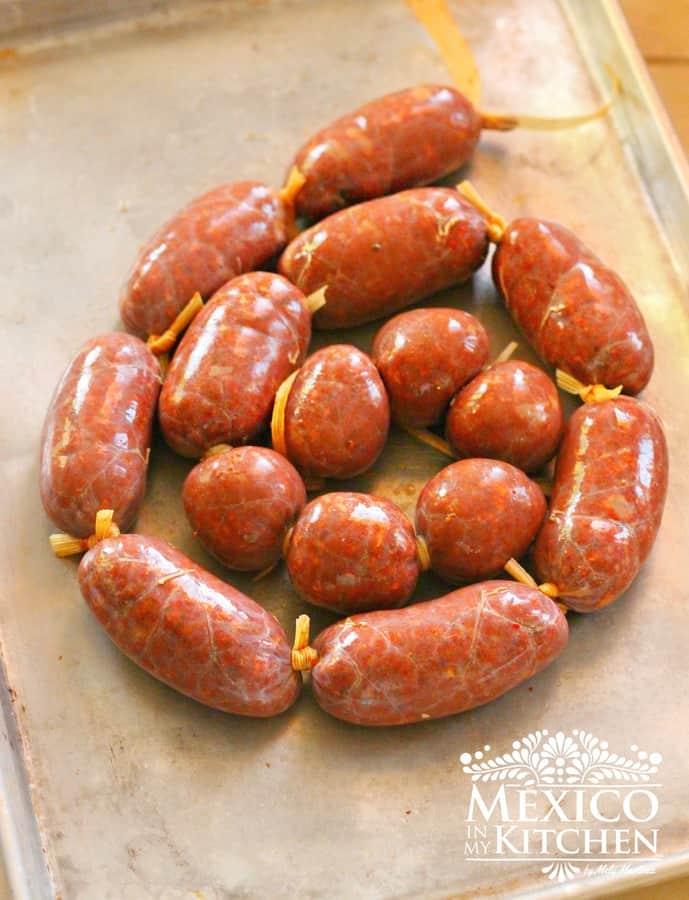
After several years of looking for a good authentic Mexican chorizo (Chorizo Mexicano) at Latin food stores and having no luck, I decided to make my own homemade Mexican chorizo.
In This Post
I'll admit, it wasn't easy at the beginning. The idea of preparing all the chorizo ingredients and stuffing the meat into the casings seemed unattractive and messy.
But in the end, it wasn't that bad, and I ended up with a juicy batch of Mexican chorizo!
Frequently Asked Questions About Chorizo Mexicano
Before I share my chorizo recipe, here are a few questions I've been asked about homemade chorizo. Believe me, you will love this recipe, is the traditional way to make it in Mexico. This recipe is great if you want to make Chorizo for sale.
What is chorizo?
Chorizo (also known as Spanish sausage or Mexican sausage) is a delicious and unique type of sausage that was brought to Latin America from Europe. It has its origins in what today are the countries of Spain and Portugal.
What is Mexican chorizo made of?
Mexican chorizo is commonly made with fresh ground pork, pork fat, a mix of herbs and/or spices, chile peppers (for both flavor and color), and vinegar. The finished product is usually stuffed into short links or casings. This type of chorizo is usually “aged”, anywhere from one day to a week.
Even though pork and beef are the meats typically used to prepare chorizo, chicken versions exist in México as well. There also used to be some exotic versions made from iguana or even ostrich meat.
It's worth mentioning the importance that the casing has when making chorizo. Some chorizo recipes only mix the meat with the rest of the ingredients, but in order for the flavors to reach their full potential, it's preferable that the chorizo be cured in its casing for 1 or 2 days.
Is Chorizo Easy to Make?
Making a truly authentic chorizo requires time and preparation. I have seen many recipes online that claim to be easy, but that is only because they use powdered spices and store-bought mixes to make it. While those recipes might still taste ok, nothing can compare to making chorizo the proper way, using dried peppers and freshly-ground spices. I promise it will be worth your time and effort!
Is Mexican chorizo spicy?
It really comes down to what you think is spicy. Between the white vinegar and the guajillo and ancho peppers added to the mix, I will say it does have a nice kick to it, but I think it just adds to the flavor of the chorizo. If you really want it to be spicy you will need to add a couple of Arbol peppers to the mix.
What is the difference between Mexican chorizo and Spanish chorizo?
Although Spanish chorizo and Mexican chorizo share a name, and both are sausages, there are many distinct differences between the two.
I will say that both the Mexican and Spanish versions of chorizo are made in a wide array of regional and cultural varieties–all of them delicious. Since Chorizo is a vast culinary topic, we attempt to provide a basic description here that applies to the most common types of chorizo.
However, when it comes down to the differences, Mexican chorizo includes dried peppers, as well as other spices like Mexican oregano. It is soft in texture, and is usually not smoked like some of the chorizos from Spain.
Chorizo from Spain and Portugal is commonly made with pork meat, though beef is not unusual as well. Its ingredients include:
- Smoked paprika
- Herbs
- Garlic
- White wine
The mix is stuffed into natural or artificial casings (ranging from short to really long links), fermented, and slowly smoked. The smoking helps to preserve the meat, and contributes greatly to the chorizo’s aroma and flavor. The final product is then air cured for several, if not many, weeks.
So, not too different from Mexican chorizo, but just enough to have distinct flavors and textures.
What Can I Use To Stuff The Sausage Casings?
I started using a small funnel, and then found a large one and trimmed the tip (to widen the opening to about ½ inch) to make it easier to work it. I will say that the stuffing process is faster if you have a Kitchen Aid with the sausage stuffer attachment.
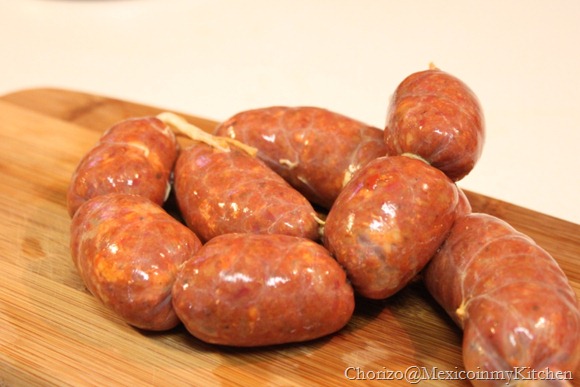
Recipe For Chorizo Mexicano
If you are worried about finding the ingredients necessary to make this recipe, don't be. Nowadays, it's actually so much easier to find everything you need at your local Latin grocery stores and markets.
For this recipe, you will probably end up with about 20 3-inch chorizo links.
Here is a list of ingredients you will need:
- Ground pork
- Ground pork belly fat
- Salt
- Guajillo peppers
- Ancho peppers
- White vinegar
- Paprika
- Garlic cloves
- Bay leaves
- Ground black pepper
- Ground cumin, freshly ground is better
- Mexican oregano
- Dry marjoram
- Coriander seeds
- Dried thyme
- Whole cloves
- Ground allspice
- Enough butcher’s twine or corn husks to tie the chorizos
- Sausage casings
Please note: For exact measurements of the ingredients listed above, scroll down to the recipe card located at the bottom of this post!
How To Make Chorizo: Step By Step Tutorial
To make things easier for you, I am going to breakdown the directions of this recipe into sections.
Prepping The Chorizo Mixture
- Before cooking, make sure to clean and wipe down the guajillo and ancho peppers.
- Remove the stems and cut them lengthwise.
- Scoop out the seeds and place the peppers in a bowl.
- Cover with hot water to soak.
- Meanwhile, grind the spices and dry herbs using a spice grinder.
- Drain the peppers and add them to a blender.
- Add the vinegar and garlic cloves and puree until smooth.
- Place the pork meat and fat in a large bowl. Add the ground mixture of herbs and spices and mix well. Add the chili sauce and combine it until everything well mixed.
- Place the chorizo mixture in your refrigerator for about a day in a well-covered glass container to allow everything to come together.
- After a day, stir the mixture and wrap them up in small packages. This is freezer friendly for several months or you can follow the next set of instructions to make your own chorizo links.
How To Make Chorizo: Step By Step Tutorial
To make things easier for you, I am going to breakdown the directions to this recipe into sections.
Prepping The Chorizo Mixture
- Before cooking, make sure to clean and wipe down the guajillo and ancho peppers.
- Remove the stems and cut them lengthwise.
- Scoop out the seeds and place them in a bowl.
- Cover with hot water.
- Meanwhile, grind the spices and dry herbs using a spice grinder.
- Drain the peppers and add them to a blender.
- Add the vinegar and garlic cloves and puree until smooth.
- Place the pork meat and fat in a large bowl. Add the ground mixture of herbs and spices and mix well. Add the chili sauce and combine it until everything well mixed.
- Place the chorizo mixture in your refrigerator for about a day in a well-covered glass container to allow everything to come together.
- After a day, stir the mixture and wrap them up in small packages. This is freezer friendly for several months or you can follow the next set of instructions to make your own chorizo links.
Stuff The Chorizo Mixture Into The Sausage Casings
- Soak the casings in warm water until soft and pliable for at least 1 hour.
- Run lukewarm water through the casings to remove any salt.
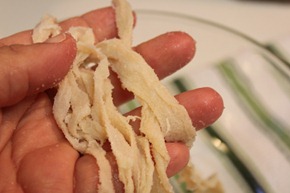
- Tie a double knot in one end of the casing, and then cut off a length of casing.

- Gather all but a couple of inches of the casing over the nozzle of the sausage stuffer or funnel.
- Start pressing the sausage mixture through, supporting the casing with your other hand.
- Pack the sausage as tight as you can, but not to the point of bursting. When you have filled almost all the casing, slip the casing off of the nozzle.

Make Coiled Sausage Links
- For a coil, tie the sausage where the stuffing ends.
- Place the sausage on a clean table and start to make links.
- Pinch the rope into links and twist in alternating directions at the indentations.
- Using butcher’s twine or corn husks, tie the rope of sausage at intervals.
- Randomly pick the casings with a thin toothpick or the tines of a fork to release any air that’s trapped.
- Hang the chorizo for a day in a dry room free of dust or insects.
Now, your chorizo is ready!
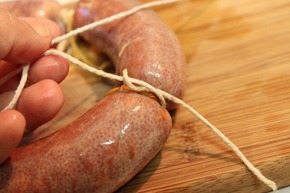
How To Store Mexican Chorizo
If you don't plan to cook or smoke the chorizo, there are a few different ways you can store the Mexican chorizo.
- You can store the prepped chorizo Mexicano in an airtight sealed storage bag or container. Label the packaging with the date and leave it in the refrigerator for up to 6 days.
- Use your food saver if you plan to freeze it. You can store uncured chorizo links for up to 12 months in the freezer.
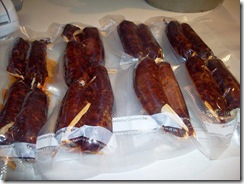
What To Make With Chorizo Mexicano
There are many recipes using Mexican Chorizo, even on my site!
You can make a batch of:
You can also add some chorizo to this Frijoles Charros Cowboy Beans Soup and Tinga Poblana.
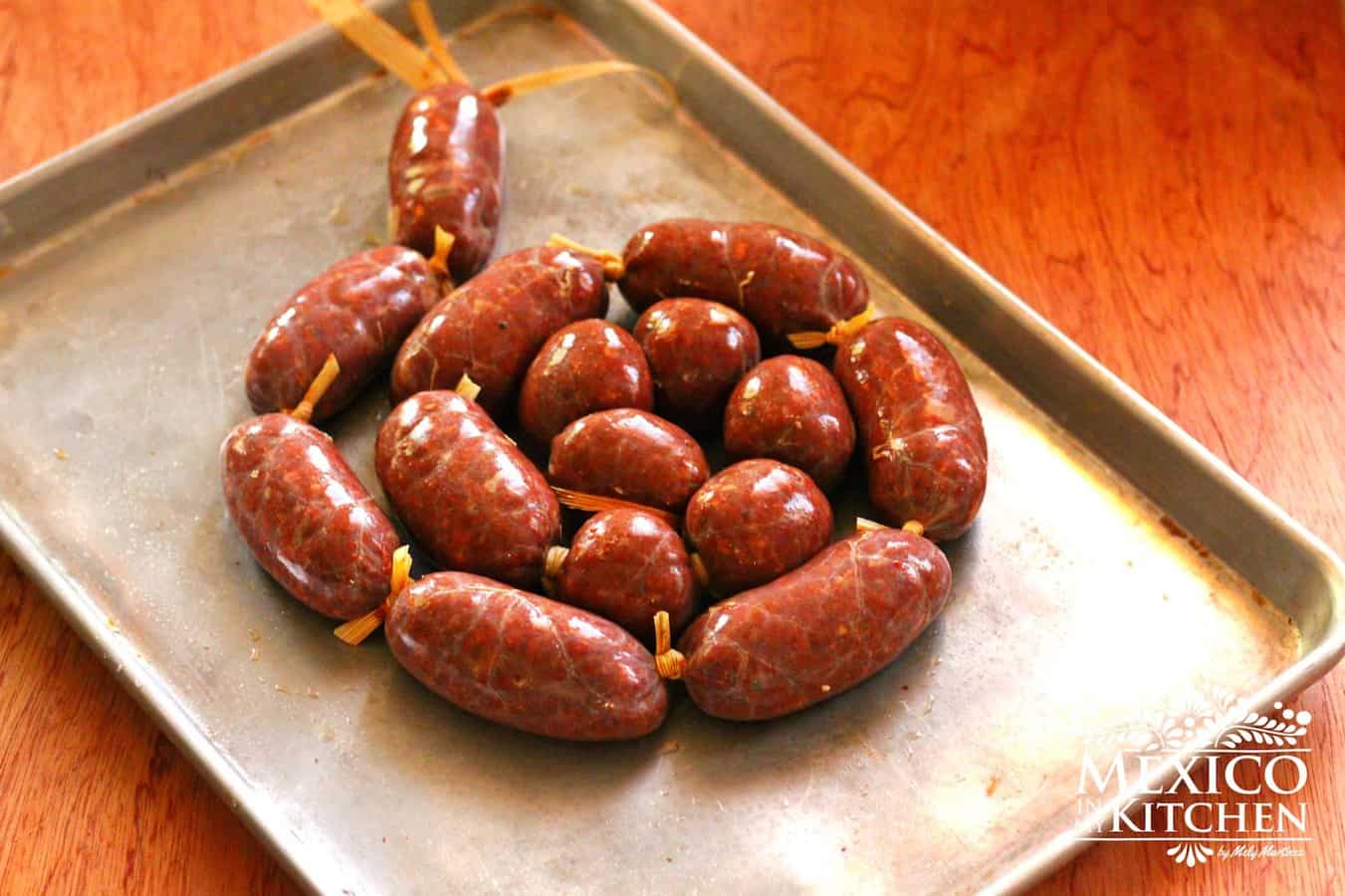
More Meat Recipes To Enjoy
If you enjoyed this recipe for Mexican chorizo, take a look at some of these other authentic Mexican recipes:
I hope you make this recipe for Mexican Chorizo! If this recipe was of any help to you, come back to let me know your experience. Please leave us a comment done below and tell us all about it!
¡Buen provecho!
Mely
📖 Recipe
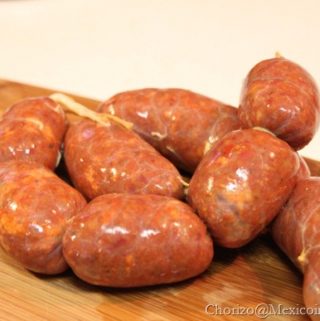
Mexican Chorizo
Ingredients
- 2 lbs. ground pork
- 6 ounces ground pork belly fat
- 2 tablespoons salt
- 8 guajillo peppers
- 6 ancho peppers
- 1 cup white vinegar
- 3 tablespoons paprika
- 6 garlic cloves peeled and minced
- 2 bay leaves
- ⅓ tablespoon ground black pepper
- ½ tablespoon ground cumin
- ¾ tablespoon Mexican oregano
- ½ teaspoon dry marjoram
- ½ teaspoon coriander seeds
- ½ teaspoon dried thyme
- 6 whole cloves
- ½ teaspoon ground allspice
- Enough butcher’s twine or corn husks to tie the chorizos
- Sausage casings
Instructions
- Wipe the peppers clean. Remove stems and cut lengthwise. Remove seeds and place in a bowl. Cover with hot water and let sit for 30 minutes.
- Meanwhile, grind the spices and dry herbs using a spice grinder.
- Discard water and place the peppers in a blender. Add the vinegar and garlic cloves and puree until smooth; set aside.
- Place the pork meat and fat in a large bowl. Add the ground mixture of herbs and spices. Mix well. Add the chili sauce and combine until well mixed.
- Place in your refrigerator for a day to season in a well-covered glass container. This step will enhance the flavor.
- After a day, stir the mixture and wrap it in small packages, it will freeze well for months. It can also be stuffed into casings.
HOW TO STUFF THE CHORIZO INTO THE CASINGS:
- Soak the casings in warm water until soft and pliable, at least 1 hour.
- Run lukewarm water through the casings to remove any salt.
- Below are the casings and corn husks strips after 1 hour of soaking in warm water, the funnel, and the chorizo mixture.
- Tie a double knot in one end of the casing, and then cut off a length of casing. Gather all but a couple of inches of the casing over the nozzle of the sausage stuffer or funnel.
- Start pressing the sausage mixture through, supporting the casing with your other hand. Pack the sausage as tight as you can, but not to the point of bursting. When you have filled almost all the casing (or used up all the stuffing), slip the casing of the nozzle.
- For a coil, tie the sausage where the stuffing ends.
- Place the sausage on a clean table and start to make links.
- Pinch the rope into links and twist in alternating directions at the indentations. Using butcher’s twine or corn husks tie the rope of sausage at intervals.
- Randomly pick the casings with a thin toothpick or the tines of a fork to release any air that’s trapped.
- Hang the chorizo Mexicano for a day in a dry room free of dust or insects. If you wish you can cover it with a cheesecloth. This step will help to cure the meat. Some of the vinegar will drip at this stage.
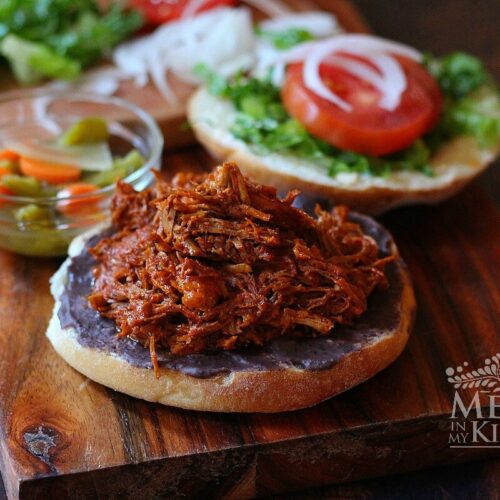
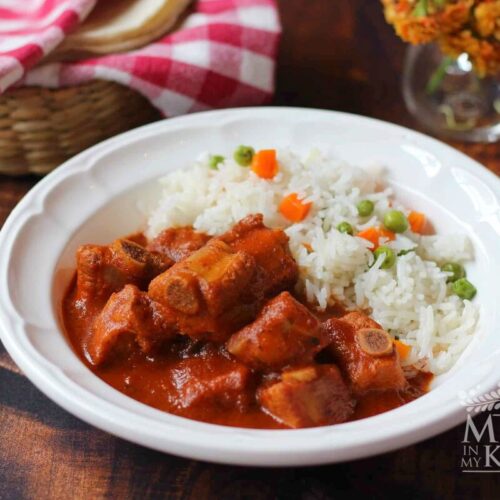
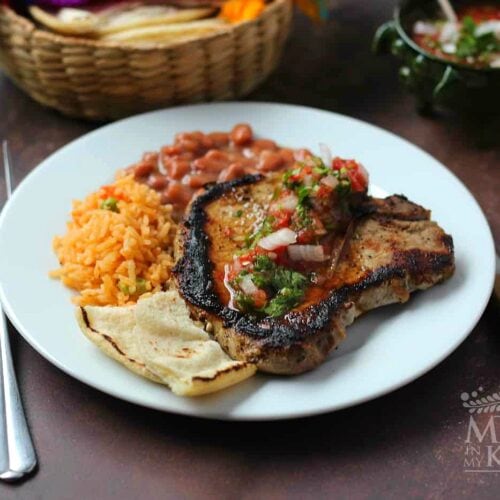
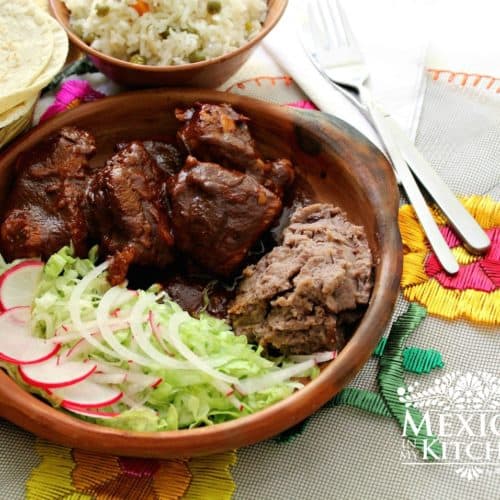
CC Lek
I almost cried from happiness when I tasted this! Recently moved from SoCal to the south. Never learned to make chorizo when we lived in SoCal because delicious, homemade chorizo was not hard to find. My husband and I have missed it dearly as it is one of his all time favorite favorites foods (Mexican style not Spanish style). I read through many recipes on the internet looking for one that was more authentic / homemade (not relying on pepper powders etc), even if it took a lot of steps to make. This was not difficult to make at all! I can't thank you enough for publishing this recipe. My husband looked at me like I was an angel when he first tasted it (boy have we eaten some disappointing chorizos since we moved!) I will be making double batches of this in the future I am sure as my friends here can finally taste how chorizo ought to taste. I can't wait to try your other recipes. Bookmarking your site now!
Mely Martínez
Hello CC Lek,
I'm so glad to hear you like the recipe. I hope you are enjoying your life in the south!
Happy cooking!
Mely
Ira R.
Do you think this can be done using tofu? I read someone said vegan substitutes but I’m not a fan of impossible meats or beans. Or do you think it needs the fat content so it all comes together? Looking for a substitute during Lent. Thank you!
Mely Martínez
Hello Ira,
I know some people make it using firm tofu. However, they cook it right away.
Crumble the tofu and add to the sauce, them cook with oil in a skillet.
Jason Hollinger
This recipe is exactly what I'm looking for. But, will be doing 30 pounds of this. Would I just math it for that amount of pork, or reduce the vinegar and pepper amount?
Mely Martínez
Hello Jason,
Yes, you multiply that ingredient list.
les
Hello from the uk. Would it be ok to use sea salt?
Regards
Mely Martínez
Hello Les,
Yes, you can use sea salt.
James
I'm confused. The recipe states to grind all spices in a spice grinder, but most of the spices in the recipe are already ground. Are they all to be ground again?
Also, when hanging to cure, is that a full 24 hours?
Thanks for your help... I look forward to trying your recipe
Mely Martínez
Hello James,
You can grind in a spice grinder or a molcajete, freshly ground is better. However, if you prefer to use store-bought ground spices that could work too. That is your choice.
Yes, you need to hang it for at least 24 hrs.
Enjoy!
Lucas G.
Would it be acceptable to skip the vinegar and maybe use something like apple juice or a mexican beer for liquid, use curing salt in place of table salt, and smoke the sausage to cure it immediately after stuffing into casing?
Mely Martínez
Hello Lucas,
Apple juice will make it sweet and won't help to cure the meat.
Curing salt sounds good.
Jennifer Kleffner
Curing salt (Cure #1) is used at a very specific quantity, 1/4 of one percent (so multiply weight by .0025) of the weight of the meat. You don't just substitute it for regular salt or you would have a toxic amount.
Tyler
Hi Mely,
I am trying to make this recipe using home-ground venison. I am making a 7 pound batch (tripling the recipe) and am questioning the number of dried chiles to be utilized, as it calls for 2 dozed guajillo and 18 ancho. It also calls for 3 cups of white vinegar which seems like a lot. Could you offer any insight into this? I am not planning on stuffing into casings but instead vacuum sealing into 1 pound portions once finished.
Mely Martínez
Hello Tyler,
For that amount of meat, I will use about 15 guajillo peppers, and 10 ancho peppers. 1-3/4 cup of vinegar will be enough. Just make sure you add enough fat to preserve the chorizo.
Ardiana Xhafa
Love Mely!!!
Juan A. Bañuelos
Great Chorizo recipe! Love the authentic flavors. It took me a while to get all the meat inside the tripe but it was worth it. It taste amazing, like I remember growing up in Mexico.
Thank you for sharing your recipe.
John Grant
I worry about leaving raw pork out. Is there a danger of spoiling. Usually air dried sausage use curing salt. I'm just concerned. Should I be?
Mely Martínez
Hello John,
I usually leave it in the kitchen, but we have the AC on.
The vinegar and salt will help cure the meat.
Cyndy G
Mely, if I can't find pork belly fat, can I use manteca in it's place? Or is there something better than the lard? Thanks!
Mely Martínez
Hello Cindy,
It is better to use a portion of meat with a higher fat content in case you do not find pork belly fat, instead of lard. Lard is already cooked and I'm not sure it will not render a good flavor.
Devin
Delicious. Made as written, except doubled the vinegar. I will be making this again and again
Ricardo Gallegos
Thank you for a great recipe, this is authentic mexican chorizo as it finest! not the powdered versions given in other websites. It takes time to prepare it, I know, but it was well worth it.
Kyle
I live in Asia and can’t find Mexican Chorizo anywhere, so I had to give this a try. OMG! It’s perfect and exactly what I want my chorizo to taste and look like. I doubled the ingredients and followed the directions exactly. I’m quite happy.
Mely Martínez
Hello Kyle,
Thank you for trying the recipe. I'm so glad you were able to replicate the recipe. Happy cooking!
Nic
Does this recipe use dried or fresh peppers?
Mely Martínez
Hello Nic,
Dried peppers, if you can find them at Latin Stores, check in Amazon. Happy cooking!
Fred Johnson
Dear Mely,
Have you considered using curing salt #1 (pink curing salt), which contains 6.25% sodium nitrite, in place of regular salt? Would this helpful to ensure safe curing?
Mely Martínez
Hello Fred,
Since this is a home-style recipe, the ingredients listed are for the regular home cook. Curing salt is used by people that make the chorizo for commercial purposes in my country. But, you are welcome to use it for your own chorizo making process. I know, it also gives a nice color to the meat.
Happy cooking!
Tom
I made this chorizo and it is very good. After letting the chorizo mixture marinate in the refrigerator overnight I cook the whole batch in my cast iron skillet and make sure it gets crumbled up. When done I put it on a cookie sheet for about 1/2 hour or so in the freezer to firm it up a little. I then put it into a large freezer bag. This makes for an easy way to make any chorizo recipe easier since the meat is already cooked and especially for my chorizo and scrambled eggs with tortillas for breakfast.
Mely Martínez
Hello Tom,
Thank you for sharing this great tip, I know many people will find it useful, including myself. Happy cooking!
Jason
Hi Mely,
Thanks so much for putting this recipe up. I live in San Jose, and grew up eating lots of chorizo. After being diagnosed Celiac, I have been forced to make most of my own food, especially with cross contamination concerns. Unfortunately, this means I can't really pick up premade chorizo from the carniceria's near me anymore.
I am planning to make a small batch to be used on the day that it is made. Would I still need to add a little vinegar if I don't plan on curing the meat at all? If so, how much would you recommend for 1 lb of ground pork?
Do you think it would still taste better than store bought if I skip the curing process?
Thanks in advance for the help.
Mely Martínez
Hello Jason,
Add at least 4 tbsp of vinegar, and yes, it will taste really good. You can play around with the spices if you want.
Jason
Thanks for the quick reply Mely...I will be sure to give an update on how it turned out. Take care.
Terri
I love you blog. I look at blogs and recipes constantly. Many I’m scrolling through for the recipe. Thanks for the recipe. I’ll be back to your blog.
Linda
Why do you need to add vinegar to the chorizo. I made it once but it called for apple cider vinegar and it tasted awful. I used the correct amount of vinegar but it was overpowering .
Mely Martínez
Hello Linda,
The vinegar is added to cure the pork meat. Otherwise, your chorizo will get spoil, which is the purpose of vinegar to cure the meat. You also need to hang the chorizo to finish the curing process, in that process, as I explain in this post, it will also drip any excess liquid (including the vinegar and its flavor. If you did not hang it, and to just place it in the fridge, it is just pork meat with spices and vinegar.
Anon
If you hang the chorizo, how will it drip the excess liquid as it is sealed in the casing?
Mely Martínez
Hello Anon,
I usually place a try underneath.
JACQUELINE R
Hi. What are the husks for?
Mely Martínez
Hello Jacqueline,
Those are optional if you want to tie each chorizo link with husk strips instead of kitchen twine.
GregN
My mother and I made chorizo using this recipe and were surprised as to how easy it is to make at home. We will never buy chorizo ever again. Next time we will also be adding Pasilla and Cascabel chili peppers to this recipe to give it a kick of spice. Thanks for sharing this recipe with us!!!
Mely Martínez
Hello GregN
Thank you for trying the recipe. Enjoy!
G. E. Boroush
Hello! -
I am vegan and do not consume any animal products. But a recipe like this can be easily adapted to whole food plant based eating. There are numerous meat analogues now on the market that can be used. But cooked beans can also be used as the medium. The magic is in the spicing and flavoring no matter what the base medium. I intend to make this because of the wonderful mix of spicing. I can tell already my family will love this recipe. THANK YOU so much for posting this for us! 🙂
Mely Martínez
Hello G. E. Boroush,
I hope you come back and let us know about your vegan version of chorizo. Happy Cooking!
Heidi Perry
Made this a few days ago with small changes to the recipe and let it sit in the fridge for a couple of days, pouring off liquid daily. This made the mixture not so wet. I also put in half the salt called for based on a previous review. I also used 10 lbs of ground pork and times the recipe accordingly. I didn't add the extra fat because my pork was a bit fatty to begin with. It is the best Chorizo I have ever eaten. Thanks for the recipe.
Mely Martínez
Hello Heidi,
Thank you for coming back and write about the changes you made to the recipe. I'm sure it will be of help to other readers. I'm so glad to know you like it.
Wanda I Morales
Mely, all I can say is wao!!! My chorizo was delicious!!! The best I have ever tasted, never again buying it canned or already packaged. I followed the recipe just the way it's written, The only thing I changed was the vinegar. I used only half a cup as I didn't use the casings. For those of you that are concerned about how long to leave it in the fridge to cure, I left it for 4 days but used it on the 3rd day to make my tacos. It didn't dripped a lot of vinegar at a time, so what I did I used paper towel every day to suck up the vinegar. I would use the paper towel all over it to absorb as much as possible. I don't think I have to go to my local Mexican taco truck anymore more :). My husband loved it to as well my co-workers. This was my first time making chorizo and the first recipe that I found while looking for one and it will be the only one from now on. I'm in love with it. This batch is now almost gone and I'm ready for a second round!
Thank you Mely! From Spfld MA
Wanda
mmartinez
Hello Wanda,
I'm so happy to know you liked the chorizo recipe. Thank you for coming back and sharing all your tips.
Wanda I Morales
Hello,
Not sure if my message from today was posted, but I just want to say thank you for your fast response. I made my chorizo today and can't wait to see what it will look like tomorrow! I didn't use the casings, but I think that I'm suppose to leave it in the fridge for a few days.
Wanda
Wanda I Morales
Hello, will be making this chorizo this weekend, do I use the skin from the pork belly or just the fat?
Thank you
mmartinez
Hello Wanda,
Only the fat part.
Michelle
So if I didn’t add the extra fat (couldn’t find any) how long will it keep uncased in the fridge? I want to leave it in there long enough for the vinegar to separate so I can drain it. Thanks!
mmartinez
Hello Michelle,
It will keep well for about 2-3 days. Then you will have to freeze it.
Margaret
I have an abundance of ground pork from a pig we slaughtered recently, and decided to try my hand at making chorizo. I am so glad I found this recipe! The blend of spices and peppers made the perfect flavor. Even more tasty than the chorizo at the local market. I let it sit in the refrigerator for a day and then cooked it instead of stuffing into casings. We ate it in tacos. Next time I will cut the salt a little if I don't plan on stuffing it, but I will use this recipe again and again. I am so happy I can make my own chorizo now! Gracias Mely!
mmartinez
Hello Margaret,
Thank you for taking the time to come back and let me know about your experience using the recipe for Mexican Chorizo. I'm so glad to know you like it. Check all the recipes using chorizo here in the blog. RECIPES WITH CHORIZO
Paparon
Mely, thanks for your recipe!! We have loved it, and we make it a few times a year in bulk, here's our quantities (note the addition of the chipotle peppers):
16 lbs. ground pork
2 lbs. ground pork belly fat
8 tablespoons salt
30 guajillo peppers
22 ancho peppers
6 chipotle peppers
2 cups white vinegar (may need to add more)
1 cup paprika
20 garlic cloves, peeled and minced
6 bay leaves (I now use powdered bay)
1 tablespoon ground black pepper
3 tablespoons ground cumin
4 tablespoons Mexican oregano
2 teaspoons dry marjoram
4 teaspoons coriander seeds
2 teaspoons dry thyme
15 cloves
3 teaspoons ground allspice
mmartinez
Hello, Paparon
Thank you for sharing this valuable information with our readers.
lety
Hola Mely, quiero tratar esta receta de chorizo, yo vivo en Montreal y no encuentro por ningún lado buen chorizo,
mi pregunta es si es necesario usar los casings, podría solamente guardarlos en bolsitas de plástico, sacarles el aire y congelarlos sin curar?
mmartinez
Hola Lety,
Si los puedes hacer, aunque como no se curaría bien el chorizo, trata de dejarlo en el refrigerador ya preparado y sin embolsar por unos dos días. Vas a ver que va soltando líquido, ese líquido se lo quitas, y ya después lo guardas en bolsitas en el congelador.
lety
gracias, lo voy a tratar
Santiago Moncada
I haven't tried your recipe yet, since I just came across it. I am from Texas, La Frontera as we call it. Across the state of Coahuila and the cit of Piedras Negras. I read your recipe and since I to have a Kitchen Aid I intend to try this recipe, have tried others before and typically use a chorizo called APCO, from San Antonio. I grew up with that but am always searching for more authentic, regional or home made recipes. I will try this and let you know how it came out, thanks for sharing. Mi abuelita viene de Monterrey pero llego a los EEUU muy chica que nunca cocino con las recetas de su mama que fallezo durante su juentud. !Gracias!
Anonymous
If you're in the Phoenix area, the best place for good chorizo (and hot, huge, fresh tortillas made with lard) is Carolina's at 1202 E Mohave Street.
Unknown
I made this for one pound of packaged ground pork, so I cut the spices in half. I'm from Texas but live in Arizona, no good chorizo to be found out here. Everybody in Texas uses Chorizo De San Miguel, it's the best. I found the taste similar, but the taste of the pork seems to be better than the san Miguel. They probably use junk pieces of meat. Next time Ill use my grinder and stuffer with some pork butt and make a larger quantity with natural casings. Thank you!
Anonymous
I've tried a few different recipes over the years and think this one is the best. I do have a #10 sausage stuffer but I see no reason to stuff it in to casings. Most recipes call for it to be loose and many markets sell it in bulk form. I used a 4.3# pork butt and 2# of back fat. The extra fat is what is needed for that beautiful grease to run down your arm. THAT is what makes good chorizo. I store it zip bags, one pound at a time. I cook three to four ounces every morning with two eggs, a jalapeno and some onion. Throw that in a flour tortilla with some cheese and you have the start of a wonderful day.
Mike Guappo,
mmartinez
Hello Mike,
I'm so glad to know you enjoyed the recipe, it was giving to my by one of my younger sister many years ago while she was studying about the Chemistry of foods. When you use the casings and hang the chorizo for a couple of days, the flavor changes after being cure without refrigeration for that time. The flavors are enhanced, I hope you try it sometime.
Saludos and happy cooking!
PS, Now, I want some chorizo with eggs! 😉
Andrew
Toluca is the place to go to for the best Chorizo in Mexico. Tacos and Tortas yes, but Chorizo is a Toluca speciality. Once a year there is even a Chorizo festival here.
Mely Martínez
Hello Andrew,
Yes, one of the best chorizos can be found in Toluca. Also, in the nearby town of Lerma.
Michael
I just made this and agree it's delicious. The salt is definitely on the high end but it's what you need if you want to dry it raw. However if you just want to eat it as fresh chorizo, you can cut it to a third (i.e., 1 tsp per pound or 2 tsp for this recipe). I'll make it again.
Susan
My husband’s breakfast every day. Except corn tortillas only!
Susan Resendiz
Make that a corn tortilla and add some black beans and you’ll have the breakfast my husband has every day! Unless he’s hungry for some chilaquiles. 😊
Eliseo Rodriguez
Mely,
I saw in one of your replies that you can use beef and chicken instead of pork to make this chorizo. What kind of fat would you use with these meats (especially the chicken)?
Gracias,
Eliseo
mmartinez
Hola Eliseo,
Personally, I would add beef fat to the beef chorizo. And no fat to the chicken chorizo. Without the fat, you will need to use the chicken chorizo as soon as possible or store in the freezer. And add oil to cook it. Actually, this is called chori-pollo in some places. Are you planning to use the casings?
Eliseo Rodriguez
I wasn't planning to, as I always cook the story bought chorizo without the casing. Is there any benefit to the casing?
mmartinez
Hello Eliseo,
The casing are useful if you are curing the chorizo, curing the chorizo will render a better flavor. But, to cure the chorizo you will need to add fat to the meat.
Monique's Floral Design
So excited to try this with venison. We are hunters and the season is near! P.S i am so addicted to your blog and my husband could not be more happy lol
Mely
I miss venison.
Happy cooking!
Ema Susanti
nice post
Sayra Abboud
Me ha gustado mucho tu receta. Yo habia buscado por todas las tiendas latinas chorizo de res, al fin encontre uno pero tenia un sabor raro tipo barbacoa! Hoy por fin me anime hacerlo, aunque me faltaron 2 especias me salio riquisimo.
Mely
Hola Sayra,
Que bueno que te gusto la receta. Y muchas gracias por tomarte el tiempo de pasar a dejar tu comentario sobre tus resultados.
Saludos!
Pensamientos Dispersos
Que bonito blog! se me antojo todooooo!. Excelente guia para cocinar autentico!
Juan V.
Saludos, Mely.
Tengo una duda en la parte de "ground pork fat". En el blog de Nora esa parte fue traducida como "grasa de puerco (lardo) molida o picada finamente".
Vivo en Mexico, no se mucho de cocina (apenas aprendiendo). No habia escuchado ese termino. Supongo que no es manteca de cerdo. Y "lard" tengo entendido que es la manteca vegetal hidrogenada (la que normalmente se usa para hacer tortillas de harina).
Asi lo pediria en una carniceria? Como grasa de puerco? Es algo diferente a la manteca, verdad?
Mely
Hola Juan V.
La grasa que indica la receta y que es necesaria para la conservacion del chorizo, yo uso la grasa que tiene el puerco pegada a la piel. Como se aprecia en la foto del enlace:
Link
En Estados Unidos, se le llama "lard" a la manteca de puerco, la que se produce al derretir la carne grasa del puerco como cuando hacemos carnitas o chicharrones. La que comunmente agregamos para hacer tamales o gorditas. Quizas por eso tradujeron la palabra "lard" como lardo. Pero esa no es la que necesitas, la que necesitas es como la que se aprecia en la foto del enlace de arriba.
En caso de que no la encuentres compra carne de pierna de puerco molida gruesa ya que esa tiene mucha grasa ya revuelta.
Espero te sirva la respuesta, por cualqueir otra duda no dudes en enviarme un correo.
Saludos
Mely
Kristina Aguirre
I would love to try this. I would like to make a ground turkey version. What kind of fat would I substitute? Do I have to cure it outside the reftigerator and if I don't, do I need to use the vinegar? Does this combo of spices taste just like the store bought ones (I live in Los Angeles). Thanks so much for sharing your authentic recipes!
Mely
Hello Kristina,
Is you are using store bought ground turkey meat, chances are it already has some fat from the same turkey. I know on must packages it says: lean Turkey meat, but the chorizo must have some form of fat to be preserved. And yes it also needs the vinegar, other wise it will turn rancid very quickly. Unless you freeze it right away, then it will last for a longer period of time.
The curing time hanging the chorizos in a airy environment will help to release extra moisture and vinegar (there will be some drippings), plus it is essential to cure an add
the characteristic flavor of a Mexican Chorizo.
The mix of spices would give you a Chorizo that tastes just like the ones sold in Mexico.
Happy Cooking,
Mely
Mely
Hello Stephen,
This recipe use dry peppers. And you can used Apple cider vinegar, some people prefer it than white vinegar. The process for curing drying doesn't change.
Enjoy!
Mely
Stephen
Mely,
just a couple of questions before I try this:
From the directions of soaking the chiles in water I am assuming that I should use dreid chiles. Is this correct?
I have seen a very similar recipe which calls for apple cider vinegar instead of white vinegar. Will this work, and will I need to adjust the drying/curing process?
Tim parker
Authentic flavor. Little to no grease left in pan. Meat is still moist.
THANK YOU!!!
COLETTE AND TIM PARKER.
NORTHWEST OKLAHOMA.
Mely
Thanks for letting me know the outcome. Now other people that also have a hard time finding the dry peppers can experiment with jalapenos.
Thank you Parker family.
Tim parker
I had all of your ingredients but the 8 peppers.
Mely
Hello Tim,
I am sure those chorizos will come great any way. In Mexico we also have green chorizo with a very different taste but still delicious. You can also use hot paprika powder or ancho pepper powder instead of the dry peppers.
Please let me know the end results.
Happy cooking!
Mely
Matthew
I would love to see the GREEN chorizo recipe:)
Tim parker
6 # of wild hog ham meat.1and a half pounds of commercial pork fat. And your recipe. Should be a on spot deal. Thanks for your help. I had to use 12 jalapinos ; as could not find the type of peppers in your recipe " the 8 " you mentioned.
Tim parker
Making this with wild hog, and garden fresh jalapinos
Diana Blanco
Hola!
Muchas felicidades por tu blog. Me gusta muchísimo! Yo soy de Monterrey y quiero hacer esta receta. Sin embargo, nunca he visto que vendan chiles anchos en donde vivo (en Vancouver). ¿Hay alguna sustitución para este ingrediente? Ojalá y si!
Mely
Hola Diana,
Que gusto que me esccribas. Mira para el chorizo puedes usar solo chile guajillo o tambien chile Nuevo Mexico. Y si de plano no encuntras ninguna usa pimenton-paprika. En Mexico hay carniceros que solo le ponen pimenton. El sabor no va a cambiar mucho.
Espero luego me dejes saber como te quedo.
Saludos,
Mely
Diana Blanco
Hola! every recipe you post looks delicious. My husband and I make this chorizo recipe last weekend. The taste is amazing! Me gusta mucho este blog, muchas felicidades. Ya he hecho varias recetas y todas han salido muy ricas :)Yo soy de Monterrey y vivo en Canadá. Quiero hacer este chorizo pero no encuentro chile ancho. ¿Sabe alguien si lo puedo reemplazar con algo más, o de qué forma puedo hacer el chile ancho yo misma? Se me estaba ocurriendo que tal vez sea igual que hacer tomates deshidratados. Saludos!
Sandy D
Mely,
Gracias el arroz salio super delicious! Lo ise con tilapia, ensalada y seasoned corn kernels.
Gracias!!
Mexico in my kitchen
Que bueno que te gusto Sandy.
Sabes, volviendo al asunto de hacer el chorizo con carne de res, me acorde que en Tamaulipas y en San Luis Potosi venden chorizo de vibora cascabel. Solo una vez lo probe ya que una compañera de escuela lo comia para ayudarla a remediar su problema con el acne.
Saludos,
Mely
Sandy D
Wow! Aque sabe? Is it good?
Saludos
Sandy 😉
Mely
Hola Sandy,
Solo recuerdo que sabia a chorizo sin ese saborcito que le da la grasa del puerco. Y como lo hacia revuelto con huevo, pues no se sentia mucho la diferencia.
Saludos!
Mely
Sandy D
Mely, do you have a recipe for green rice? Had some at someones house & was embarassed to asked for the recipe. 😉
Thank you.
Sandy, chicago.
Sandy D
I have a question, I don't eat pork. Can the same recipe be used with ground chuck? I've been looking everywhere around here & no one sells beef home made choriso only pork. ;(.
Thanks.
Sandy, from chicago
Mexico in my kitchen
Hello Sandy,
Yes, you can make it with beef if you want and also with chicken.
I had tried the chicken chorizo and it really taste good.
Saludos,
Mely
Alexandra Gillette McStay
I really want to try this, but have a question for you. I live in the Caribbean, and the thought of leaving the sausage out for a day in a non air conditioned house scares me.... will the chorizos be ok(food safety wise) if I do that? I know you cook the meat, but that just sounds scary.
Mexico in my kitchen
Hello Alexandra,
I understand your concerns, the vinegar helps to cure the meat but you can just leaven them for some hours outside. Sometimes I just leave them for 4 hours and then keep them hanging in my kitchen.
mar4tha
I LOVE YOUR RECEPE IT TESTE REAL GOOD AND THE INSTRUCTIONS WERE EASY TO FOLLOW
Mexico in my kitchen
Hello Martha,
I am so glad you like the recipe.
Mely
Goose
This recipe looks awsome!!! I love chorizo and certainly going to try this! I saw a Rick Bayless show a while back and his chorizo recipe seemed too simple and after I read yours, this certainly looks incredible and I'm sure it will be delish!!! I like my chorizo plain. I brown some onion with a LITTLE oil, add a few links of chorizo, brown it for a few min, then I add chunks of tomato and continue to cook it 'til done. You can make tacos, sopes, tostadas...you name it!!! I will keep you posted. Thanks again.
Gustavo in Yorba Linda, CA
jerry
Use apple vinager instead of the white vinager and you won't have that vinager taste
Mexico in my kitchen
Hola Mountainnb,
Mchisimas gracias por tomarte el tiempo de visitar la pagina y dejarnos tu amable comentario.
Saludos donde quiera que estes.
Mely
Mexico in my kitchen
Hola Lyss,
Se me hizo curioso saber hace tiempo que en California venden el chorizo con carne de res y molida mu finita. Cuando puedas ir a comprar el que te gusta de San Diego aprovecha a comprar suficiente para congelar.
Y si algun dia te animas a hacerlo en casa esta receta no falla.
Saludos y gracias por tu visita.
Mely
Lyss
Hola Mely!
Gracias por la receta! Me choca ir a los mercados mexicanos para comprar chorizo de res. Muchos los venden con los desechos o con mucho gordo y nervio. Encontre un mercado, Henrys en San Diego, que es sabroso pero me queda lejos!
mountainb
Excellent recipe! We tried at home for the first time. It is really good! Excelente receta! Que bueno que estas compartiendo el sabor Mexicano con todo el mundo.
Anonymous
Hi - I am really glad to discover this. great job!
Shu Han
omg you can make them yourself?? that's going to save me so much money! i'm definitely bookmarking this! thanks!
Mexico in my kitchen
Hi! Maria,
Thanks a lot for stopping by and letting me know. I like to know how a recipe turns for other cooks.
Happy to know you like it.
Mely
Maria♥
Mely,
I made it and it is delicious!!!!!
Thank you so much!!!
All the best,
Maria♥
Maria♥
Thank you so very much, can't wait to try it!!!
-Maria♥
Mexico in my kitchen
Hola Maria,
You can definitely add the oil until cooking time. The pork fat helps preserve the meat. If you are not using it try to keep the chorizos in the fridge as soon as you make the mixture of the meat with the spices.
Thanks for stopping by and come back again.
Happy cooking!
Mely
Maria♥
Hola Mely,
Thank you for your recipe. I am not using the fat. Can we mix cooking oil in the meat before cooking? Or does it have to be in the pan?
Thank you,
Maria
Mexico in my kitchen
Hello Trish,
Yes, you could make them into patties and freeze them.
Saludos,
Mely
Trish
so the chiles are dry? this sounds fabulous. I had chorizo once and I loved it. I bought some in the store but it was awful, very greasy and fatty. I was wondering about making it myself. And I could just make it into patties, instead of putting it in casings?
Mexico in my kitchen
Hola Maria,
Que gusot saber que te quedo sabroso el chorizo.
Un abrazo para ti tambien y gracias por tu visita.
Melt
msmariamolina
hola mely estoy fasinada pues no se como di con tu blog buscando una buena receta de como preparar un buen chorizo,casero y la verdad que lo prepare y me salio muy sabroso.gracias por tomar tu tienpo para conpartir esas buenas recetas con todos nosotros.un besoy abraso de tu nueva amiga mary saludos de aqui arlington,texas,va!!!!!!!!!!!!!!!by.
Mexico in my kitchen
Hello John,
I made some phone calls and this is what I found out in Greenley, CO. The Avanza Supermarket has a meat section "carniceria" and they sell chorizo made by their mexican employees. Since I have not taste it, I can't tell you if the flavor will be the one you are looking for but why don't you give them a try.
This is the address:
3635 W 10th St, Greeley, CO (Between 36 and 37)
(970) 351-0727 1.5 mi W
I hope this helps.
Saludos,
Mely
Jluna
I live in Greeley, CO. Does anybody know of a place where I can buy chorizo like you all are makin? I'm 70 years old and remember eating some real good tasting chorizo. Can't buy anything like it anymore.
Thanks for any help!
John
Anonymous
Hola,
I made the chorizo for the first time, it tastes just as I remember it.
I can't thank you enough.
Juan M.
Anonymous
como le ago para sacar la receta en espanol
kcrake
Yep, it was (is) a lot. I make sausage once or twice a month, and since my sausage stuffer holds 5 lbs, I tend to adjust recipes to make that much (or close, anyway). It just seems like with all the mess and cleanup involved, I might as well make enough to make it worth the time.
I also tend to give some away to friends and neighbors.
What you described about the vinegar is exactly what happened. It separated from the meat, and I poured it off. Still, I might try just a bit less next time I do this.
Thanks again!
KC
Mely (mimk)
Hey kcrake,
Just a question:
Isn't that a lot of chorizo? When I make this recipe it last 6 months since we are a small family.
Mely (mimk)
Hello kcrake,
You know the same feeling happened to meet the first time I tried. I was sure I did something wrong.
The vinegar will drip from the chorizo casings while hanging and during the next days, the chorizo will dry a little but the peppers and spices flavors will be there. If you didn't use the casings and have the chorizo in a container the vinegar will separated from the meat just drain it. It needs the vinegar to cure but will release it with the passing days even in the fridge unless you freeze it right away.
I do hope this works for you, and thanks a lot for stopping by.
Have a great day!
kcrake
Hi,
I tried your recipe (and actually I doubled it), and I'm somewhat surprised at the amount of vinegar, and the strong taste it leaves. The chorizo is good, but that darn vinegar taste subdues the peppers and other spices. Does that seem right to you? Did I do something wrong? Would doubling the recipe mean I should have used less vinegar?
Thanks for the recipe, and thanks in advance for any thoughts you might have!
Mely (mimk)
Hola Oscar,
Gracias por ese idea de usar el aluminio para proteger carne. Y gracias por pasar a visitar, espero verte pronto otra vez por aqui.
Anonymous
Recomiendo que lo que guarden en el condelador lo envuelban en aluminio. La carne se conserva bien y no sufre las quemadas del hielo cunado se deshiela. Y les durara mas tiempo en el congelador. Gracias por la receta.
Oscar
Mely (mimk)
Hola Oyuki,
No sabes que gusto me da que te haya gustado. Guardalo en el congelador en porciones pequenas y te dura bastante tiempo. Ya sabes que lo puedes cocinar con huevo, papas, en salsa, en tortas, bueno tu has de saber mejor en que te gusta cocinarlo.
Saludos y gracias por visitarme.
Anonymous
Hola Mely,
OMG! este "homemade" chorizo esta super rico! nada mas hize la mitad y me salio estupendo. Muchisimas gracias por compartir todas tus recetas, te lo agradezco de todo corazon.
bye,
Oyuki
Mely (mimk)
Hola Bere,
Gracias por visitar el blog. Para hacer una libra de carne solo usa la mitad de los ingredientes, con respecto al sazon de las especias eso lo puedes ajustar a la hora de cocinar el chorizo si sientes que es muy poco la mitad de lo que dice la receta. Puedes evitar el uso de la grasa, solo asegurate de guardar el chorizo una vez hecho en el congelador y a la hora de cocinar le agregas un poco de aceite al sarten donde lo pienses guisar para evitar que se te pegue.
Dos libras no es mucho chorizo, si te animas a hacer las dos libras solo guardalo en pequenas cantidades en el congelador y asi solo sacas lo que vayas consumiendo. El chorizo te dura hasta 6 meses en el congelador.
Si tienes alguna otra duda por favor dejame saber.
Saludos y que sigas cocinando rico!
Anonymous
Hola,
Quisiera saber si tienes la receta para solo 1 lb.
Ya que en mi casa solo somos mi esposo y yo.. y 2 lb se me hace mucho para los dos..
Otra pregunta.. es posible quitar la grasa.. para hacerlo uno poquito mas saludable.. jejej..
saludos
Bere
Mely (mimk)
Hello Ethan,
I love that name: Ethan.
Yes, it is 2 Tablespoons, but you can always check the salt before placing the meat inside the casings by cooking a little portion of it in a skillet and also taste if the seasoning of herbs and spices are to your liking.
Happy cooking and thank you for stopping by.
Mely
Anonymous
Hello,
Thank you for the recipe! Isn't 2 tablespoons salt a lot too much? I will try it with teaspoons and see what happens.
Thanks again!
Ethan
Mely (mimk)
Hola Dyanna,
If you lived close by I will share some chorizo with you. I just made a 6 month batch last week.
If I ever visit up north maybe we could drop some by your place.
Have some cooking.
Anonymous
Hello Ethan, I'm sure that Mely has researched her recipes before printing them. On the other hand, I make a lot of Sausages every year, but they call for Nitrates or Nitrites to *HELP PREVENT* Botulism. In the old days they just used a lot of Salt.
So with that being said, and the final step is leaving them hang overnight, that amount of Salt (2 Tablespoons) will be something that you will rely on to keep Bacteria from Forming while hanging overnight as well as a Seasoning. She mentioned that there might be a puddle where the meat is hanging. That's from the Salt removing the Blood, and other impurities and allowing all of the Flavor Profile to wake up.
Dyanna
Thank you SO MUCH! I may be British, but I grew up in Los Angeles with a Mexican nanny, Jesusita! I loved chorizo and ate it constantly until I moved to the East Coast where I can only fine the cured Spanish kind. If I have to make it myself, I bloody well will! Thank you for making that possible!
Dyanna
Mely (mimk)
Gracias Hilda,
Seguire visitando tu blog ya que tienes ahi varias recetas que quiero cocinar.
Saludos,
Mely
Hilda
Hola Mely...
Muchas gracias por visitar mi blog y gracias tambien por invitarme al tuyo, me gusta mucho la comida mexicana.
Estos choricitos tienen que estar buenisimos. Estupendos para una barbacoa.
Poco a poco tendrás una recopilación estupenda.
Prometo visitarte siempre que pueda.
Muchos besos
Hilda
Mely (mimk)
Gracias Nora,
Sobretodo por animarme a hacerlo.
Un abrazo!
Mely
Nora
Mely, te auguro mucho éxito con tu blog de cocina mexicana, te quedó muy bien tu primera entrada en el blog, muchos lectores se van a deleitar viendo y cocinando tus recetas. Muy pronto tendrás miles de visitantes. Un gran beso!
Peter
I want to learn more about making sausages, I look forward to establishing my own business